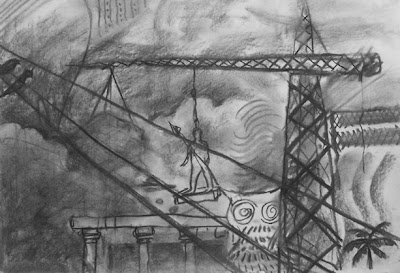http://www.gagosian.com/exhibitions/davies-street-2006-10-jeff-koons/
(Added 13 Jan 2007) Check out this amazing creation while it's still available on the net.
Thursday, December 21, 2006
Wednesday, December 20, 2006
Cezanne: That Pedestal
 This drawing happened the wrong way round. I was looking at a Cézanne still life and scribbled this diagram of the composition onto the back of an envelope. A few weeks later the diagram, lying on the desk, floated into consciousness. And all of a sudden, there it was: the reason for Cézanne‘s off-centre pedestal. It had to be off-centre or else he’d have had to repaint the fruit entirely, moving the main weight to the right. Instead he moved the pedestal to the left, under the centre of gravity. This was a kind of eureka moment for me, and I pass it on as a Christmas present to my (rare and much appreciated) readers.
This drawing happened the wrong way round. I was looking at a Cézanne still life and scribbled this diagram of the composition onto the back of an envelope. A few weeks later the diagram, lying on the desk, floated into consciousness. And all of a sudden, there it was: the reason for Cézanne‘s off-centre pedestal. It had to be off-centre or else he’d have had to repaint the fruit entirely, moving the main weight to the right. Instead he moved the pedestal to the left, under the centre of gravity. This was a kind of eureka moment for me, and I pass it on as a Christmas present to my (rare and much appreciated) readers.Much has been written about Cézanne‘s composition, which somehow works in spite of oddities like this. Or rather, this way of looking at it helps to explain why his composition works so well. In this case, I'm proposing that the off-centre pedestal was not random or arbitrary, and that it was not a vague device “to strengthen the composition”; and further, that Cézanne was not consciously inventing a revolutionary school of painting. Rather, I'm saying that he moved the pedestal because everything on earth is subject to the law of gravity, and it suited his pictorial purpose better to move the pedestal rather than to move the fruit.
This completes the thought about Cézanne‘s pedestal which was originally mentioned in a discussion about the artist's intention.
(Edited Jan 10, 2007 -- rephrased and cut but the meaning not changed)
.
Friday, December 15, 2006
Monday, December 4, 2006
Oxford online short courses
Oxford University's Continuing Education department's website has published a discussion about Jackson Pollock in which yours truly took part during an online art history course last year. Log in as a guest to read the discussion.
More info about Oxford's online art history courses here. They also offer short courses (for credit) in Philosophy, Literature, and History of Architecture.
More info about Oxford's online art history courses here. They also offer short courses (for credit) in Philosophy, Literature, and History of Architecture.
Subscribe to:
Posts (Atom)
